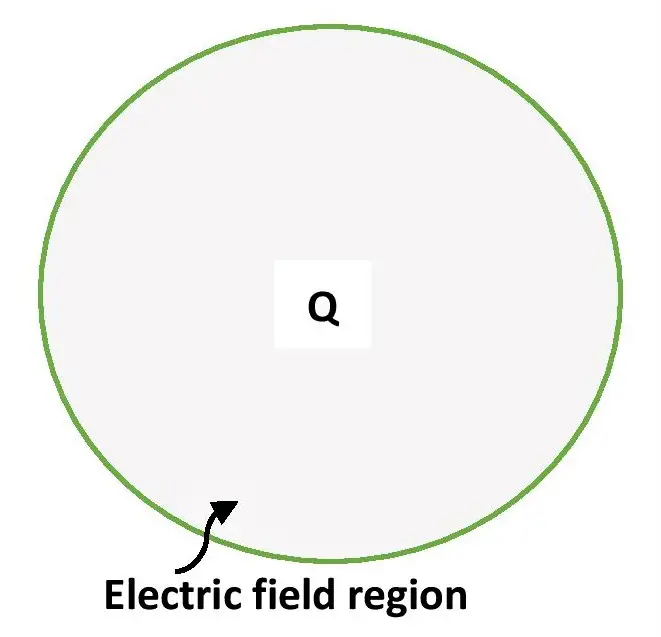In the first two articles on Electrostatics, we learned about electric charges and their distributions on a Conductor. We became to know that a static electric charge produces an electric field and a moving charge produces a magnetic field around it. Electric charges can move due to electrostatic force and this force comes from the electric field. In this article, I’m going to explore the Electric Field and its Intensity.
Contents of the article:
- Electric Field
- Definition of Electric Field
- Formula of Electric Field Intensity
- Force on a charge placed in an external electric field
- Unit of Electric Field Intensity
- Dimension of Electric Field Intensity
What is an Electric Field?

Electric Field is the region around a charge inside which this charge interacts with other charges. If the electric field is due to a positive charge then it will attract other positive charges and repels other negative charges within this region.
This region is a spherical region for a point charge. But, it may not be spherical for other charge distributions. The charge that creates the electric field is known as the source charge and the charges that experience an electric force in that region are the test charges.
What is the Intensity of Electric Field?
Electric Field and its intensity are not the same things. Electric field Intensity at a point is the strength of the electric field at that point inside the field region.
The Electric field Intensity at a point inside the electric field is defined as the electric force on one coulomb positive charge placed at that point. So, it is nothing but the electric force per unit positive charge. It is denoted by the letter E. Some authors write electric field intensity as the Electric field. But these two terms are conceptually different.
If a positive charge +Q produces an electric field E around it, then the electric force on a positive q charge in this electric field region is F = qE. Electric field Intensity (E) is a vector quantity that has the same direction as that of the electric force.
Electric Field Intensity formula
One can determine the expression or formula for electric field intensity directly from Coulomb’s Law or by applying Gauss’s law of electrostatics.

The strength of intensity of electric field (E) at r distance produced by a positive charge Q is, \color{Blue} E = K \frac{Q}{r^2}………(1)
This is the expression for electric field intensity. Sometimes, it is called the electric field formula.
where K is coulomb’s constant.
In the SI system, k = 9×109 and in the CGS system, K = 1.
Again, the relation between the magnitude of electric field intensity and electric force is F = qE.
What is the direction of electric field intensity?
Equation-(1) gives the magnitude of electric field intensity. Since it is a vector quantity, it has a direction. One can find the direction by using the F = qE relation. Force (F) is a vector quantity and charge (q) is a scalar. So, the direction of E will be the same as that of the electric force.
If a positive charge creates the electric field, then its direction will be outward i.e. away from it. But for a negative charge, the direction of the electric field will be inward i.e. toward the source charge.
Units of electric field intensity
One can find the unit of electric field intensity from the equation, F = qE or, E = F/q
We know that the SI unit of force is Newton (N) and the SI unit of charge is Coulomb (C).
So, the SI unit of electric field Intensity is N/C. It has another SI unit as Volt/meter (V/m).
CGS unit of electric field Intensity is dyn/statC or dyn/esu.
Dimension of the intensity of electric field
The dimension of force is [ MLT-2 ] and the dimension of electric charge is [ TI ]. Now, the dimension of electric field intensity is equal to the dimension of electric force divided by the dimension of electric charge.
So, the dimensional formula of electric field intensity is [ MLT-3I-1 ].
Difference between electric field and electric field intensity
The electric field is the region around a charge inside which it can interact with other charges. But its intensity at a point gives the strength of the field at that point. Electric field intensity is actually the electric force on a unit positive charge placed inside the electric field. In higher classes, the term electric field itself represents its intensity. Because there are no applications of the region around the charge. But the strength of that region is important.
Numerical problems on electric field
- What will be the electric field at a point at a 10 cm distance from a +5 C charge? If we place another +2 C charge at that point, what will be the electrostatic force on +2 C charge?
Hints: Use equation-(1) to find the electric field and use Coulomb’s law to find the electrostatic force.
This is all from this article on the definition, unit and formula of electric field and the intensity of electric field. If you have any doubt on this topic you can ask me in the comment section. In the next article, I’ve discussed how electric charges apply force to each other i.e. Coulomb’s law of electrostatics. Click on the Next Article button below to read that article.
Thank you!
Related posts:
- Formula for Surface Charge density
- Electrostatic Potential
- Coulomb’s Law of electrostatic force
- Gauss’s law of electrostatics
- Properties of electric field lines
18 thoughts on “Electric Field Intensity – definition, formula, units”
Comments are closed.